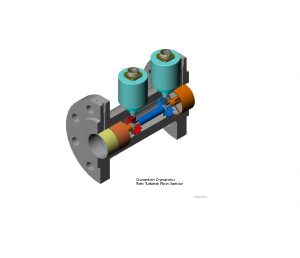QUANTUM DYNAMICS was founded in 1959 to address specific US military metrology requirements,
many of which were/are classified.
Contributions to Aerospace and National Defense Programs
Some of our noteworthy metrology achievements are:
+ The two phase cryogenic mass flow measurement systems used to fuel rockets and spacecraft.
+ The 1/3 atmosphere ventilation monitoring/control system for the SKYLAB manned orbital laboratory.
+ The flow measurement systems that performed all Apollo missions’ mid-course correction, balanced
flow thrust measurement/control that landed the Lunar Excursion Modules (LEMs) upright on the moon,
and the Apollo 13 rescue trajectory. These were, unbeknownst to television viewers around the world,
the most widely viewed examples of precision flow metrology in history.
+ The wide range turbo fuel flow measurement systems that are the de-facto standard flow measurement
systems for jet engine test stands (JETS). Standardized in all military/civilian, fixed/mobile, developmental
/production JETS, these high precision flow systems remain a major contributor to the development
of ever higher efficiency gas turbine engines, and are the only flow systems capable of performing
a one second military SNAP/RAPIDACCEL test using a single sensor.
+ Nuclear materials accounting of D2O “heavy water” and tritium gas, requiring the highest levels of quality control and accuracy.
+ The flow transfer standard systems to inter-compare the primary standards at various Class 1 military
calibration laboratories, and to calibrate a wide variety of conventional “flowmeters” in the field.
+ The tachometer calibrators used in virtually every calibration laboratory in the world. General purpose
laboratory and aircraft/helicopter specific models are available. We are the only organization in the
world that manufactures tachometer calibrators on a regular production basis, and also thus the only
organization that provides continuous and ongoing support for the systems that monitor the speed of
virtually all critical rotating assemblies.
+ The multi-channel, multi-function, programmable counters used in US military mobile JETS, monitoring
T1 and T2 engine RPM, flowrate, and engine vibration.
Note that fuel flowrate, engine shaft RPMs, and engine vibration are the most critical performance param-
eters in gas turbine engine test besides thrust — and the pilot’s primary cockpit indicators. QUANTUM
DYNAMICS measures the flow, verifies the engine tachometers, and provides the indication thereof: we
are a critical element of modern jet engine development and test.
QUANTUM DYNAMICS has continuously maintained its status as both a US Defense Logistics Agency
“Certified Quality Vendor” and US Navy “Quality / Best Value Contractor”. In many critical applications
QUANTUM DYNAMICS was deemed “sole qualified bidder”.
Unlike many other manufacturers, QUANTUM DYNAMICS designs and delivered products rigorously fulfill
contract specifications. Contracts must be fulfilled, and not just made on the basis of advertisement.
Increasing Use in Civilian Applications
Over the course of years, the civilian public has become aware of the
excellent performance of QUANTUM DYNAMICS’ systems. They have been used in:
+ Precision custody transfer systems for petrochemicals and natural gas, whereby one major South
American petrochemical company has standardized their use, and requires their customers to also purchase
same. This has eliminated millions of dollars per year in custody transfer disputes.
+ Fuel gas measurement in natural gas fired power plants to minimize emissions and fuel consumption
by providing caloric flow measurement that allows combustion to be controlled at the stoichiometric
air/fuel ratio. These systems frequently save millions of dollars per year in fuel costs, while reducing
emissions.
+ Precision blending and batching applications.
+ Pipeline leak detection systems. Per the pipeline industry’s standard desk reference Pipeline Rules of
Thumb Handbook, “They are outstanding for leak detection in gas lines”.
+ Measurement of fuel consumption on vehicle test stands, to improve fuel efficiency.
+ Automotive EGR test stands. Etc.
For well over one half century, QUANTUM DYNAMICS has been honored to have undertaken some of the
most critical flow metrology applications in history. Unlike many/most other manufacturers of “flowmeters”
who are focused solely on large volume production and sales, we continue to maintain our technological
leadership through the combination of scientific expertise, engineering excellence, and manufacturing
prowess.
A more detailed history of QUANTUM DYNAMICS is available on request.
QUANTUM DYNAMICS Patented Twin-Turbine Flow Sensor
Since the QUANTUM DYNAMICS’ twin-turbine flow sensor has played such a vital role in aerospace flow
metrology history, we provide a brief introduction to its design features and purpose.

As illustrated in the above depiction:
. The slave turbine is rigidly attached to the shaft. Flow passing through the flow sensor causes the
slave turbine to rotate, driving the shaft.
. The indicator turbine is mounted on bearings on the driven shaft, and rotates in the same direction
as the slave turbine / shaft assembly, when flow is present.
. The shaft is supported at both ends by bearings that are mounted in the upstream and downstream
supports. Both supports are machined from solid bar, and the upstream support includes flow pro
file control elements. The supports are positively retained by sensor internals of equal inside diameter,
resulting in a smooth flow path. Unlike lesser flow sensors, no snap rings are used, since the
failure of snap rings would result in the loss of flow sensor internals — commonly damaging down
stream equipment — and, furthermore, snap ring rotation changes flow path geometry / flow sensor
calibration.
The turbine system has several important benefits:
1. The bearing friction for the indicator turbine is virtually zero throughout the normally used flow
range. This virtually constant zero bearing friction leads to
a. Extremely high repeatability, resolution and response throughout the flow sensor’s range,
b. Extremely high linearity (R > 0.9999) over very wide (200:1) flow ranges, and
c. Extremely long indicator turbine bearing life, resulting in extreme calibration longevity.
2. The combination of bearings significantly increases the rangeability of the flow sensor: even when
the slave turbine / shaft assembly bearing friction increases, the indicator turbine continues to operate
linearly at even higher angular velocities with minimal bearing friction. This feature also allows
the QUANTUM DYNAMCS twin-turbine meter to withstand flashing cryogens.
Thus, in accordance with its name, the slave turbine performs all of the work that is necessary to over
come the frictional forces for the indicator turbine, allowing the latter to have optimal fluid dynamic
response over extremely wide flowrate ranges. Moreover, should the slave turbine / shaft bearings begin
to wear, the indicator turbine bearings continue to provide accurate flow indication — a critical feature in
“mission essential” applications.
In addition to the above fluid mechanical considerations, QUANTUM DYNAMICS systems utilize our
patented zero drag cryotronic pickup and patented high resolution signal acquisition techniques. The
non-retarding pickup and high resolution techniques contribute significantly to the repeatability, respon-
siveness, accuracy, rangeability, and longevity of the sensor’s calibration. No gear/index inertia/friction
retards sensor response.
In critical high reliability applications, the slave turbine can be be equipped with an optional independent
pickup leading to a redundant flow sensor with self diagnostic capabilities within a single flow sensor
body.
For the above reasons, QUANTUM DYNAMICS’ twin-turbine flow sensors are the de-facto standard flow
sensors for critical flow measurement applications requiring very high accuracy, response, reliability, and
longevity — from Zero-G manned spacecraft control systems to serving as “outstanding meters for leak
detection purposes on gas lines.”
See the endorsements page here.
